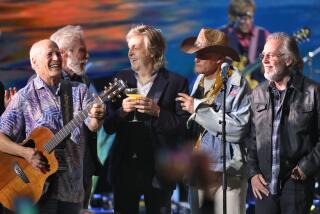George Duke’s NBA Interest: a Technical Foul
- Share via
A single burning question was asked repeatedly during keyboardist George Duke’s first of two shows Friday at the Hyatt Newporter’s outdoor amphitheater: “What’s the score?”
That the concert was held during an NBA finals game may have explained why less than half of the seats in the pastoral Newport Beach performance space were occupied. “How many basketball fans do we have here tonight?” Duke wanted to know early on. He was greeted with cheers and a nearly unanimous show of hands. “I can’t believe all of you gave up the game to come hear me,” he responded. “I should have paid for your tickets.”
That act of benevolence wouldn’t have cost him much, considering the minuscule turnout. In addition to explaining the small crowd, basketball may have been the reason the usually enthusiastic funk-and-fusion veteran gave such an unfocused performance. He was distracted.
“What’s the score?” became a sort of running gag throughout the evening.
Much like the Utah Jazz basketball team, jazz, the music, was the loser that night. Not that the concert didn’t have its moments. Even the gentlemen from Utah were ahead at various times during the game, if the scores shouted down to Duke from the hotel balconies could be believed.
Duke and his four-piece band came out running with “Rebop,” an instrumental number that combined the best elements of his jazz and funk background. Backbeat and swing, jazz phrasing and soul met in a display that brought together elements of Duke’s keyboard career, ranging from his days with saxophonist Cannonball Adderley to his fusion duets with bassist Stan Clarke.
But from there, with help from vocalists Lori Perri and Jim Gilstrap, the keyboardist concentrated on his pop history, performing songs that he wrote and/or produced for such figures as Deniece Williams and Jeffrey Osbourne as well as himself. And while Duke has previously acquitted himself well with this material, on this night his mind didn’t seem to be on his work.
“What’s the score now?”
Least interesting was his medley of vocal songs that spanned some 30 years of his career. He began with the sort of jazz he played in the ‘60s backing a then-unknown San Francisco singer named Al Jarreau, and proceeded to his very first vocal number, “Feel,” from the 1974 BASF/MPS album of the same name, then continued through his popular “Dukey Stick” period.
None of the songs were given complete performances, and many of them trailed off before Duke launched into self-promotional anecdotes about his days with composer Frank Zappa, violinist Jean Luc Ponty and drummer Billy Cobham. He punctuated these stories with questions about . . . well, you know.
Duke had a chance to take the lead during his final number, the ballad “No Rhyme, No Reason,” as he set off showing the kind of natural touch on synthesizer that sets him apart from the electric keyboard pack. But he then chose to dwell for what seemed an eternity on a single repeated trill in much the same way Kenny G eternally holds a single note.
Even with Duke’s theatrics--at one point he was down on his knees still warbling on the same two notes--the ploy, like the show itself, had all the effect of a missed basket.
More to Read
The biggest entertainment stories
Get our big stories about Hollywood, film, television, music, arts, culture and more right in your inbox as soon as they publish.
You may occasionally receive promotional content from the Los Angeles Times.








